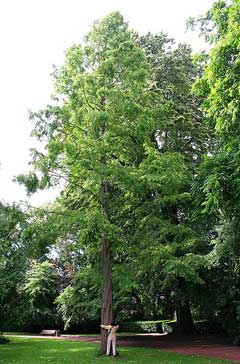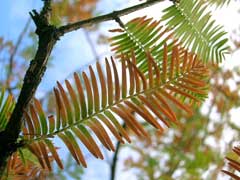 |
|
http://commons.wikimedia.org/wiki/User:Jean-Pol_GRANDMONT |
 |
| http://www.flickr.com/photos/37574471@N00 |
Translate this page:
Summary
Main Bloom Time: Early spring, Late spring, Mid spring. Form: Pyramidal.
Physical Characteristics

 Metasequoia glyptostroboides is a deciduous Tree growing to 15 m (49ft) by 4 m (13ft) at a fast rate.
Metasequoia glyptostroboides is a deciduous Tree growing to 15 m (49ft) by 4 m (13ft) at a fast rate.
See above for USDA hardiness. It is hardy to UK zone 5 and is not frost tender. It is in flower from February to March, and the seeds ripen from October to November. The species is monoecious (individual flowers are either male or female, but both sexes can be found on the same plant) and is pollinated by Wind.
Suitable for: light (sandy), medium (loamy) and heavy (clay) soils. Suitable pH: mildly acid, neutral and basic (mildly alkaline) soils and can grow in very acid soils.
It cannot grow in the shade. It prefers dry moist or wet soil and can grow in water.
UK Hardiness Map
US Hardiness Map
Synonyms
Habitats
Woodland Garden Canopy; Hedge; Pond; Bog Garden;
Edible Uses
References More on Edible Uses
Medicinal Uses
Plants For A Future can not take any responsibility for any adverse effects from the use of plants. Always seek advice from a professional before using a plant medicinally.
None known
References More on Medicinal Uses
Now available: PLANTS FOR YOUR FOOD FOREST: 500 Plants for Temperate Food Forests and Permaculture Gardens.
An important new book from PFAF. It focuses on the attributes of plants suitable for food forests, what each can contribute to a food forest ecosystem, including carbon sequestration, and the kinds of foods they yield. The book suggests that community and small-scale food forests can provide a real alternative to intensive industrialised agriculture, and help to combat the many inter-related environmental crises that threaten the very future of life on Earth.
Read More
Other Uses
Hedge Hedge Soil stabilization
Plants can be grown as a tall hedge[29]. Plants have an extensive root system and so they are used to stabilize river banks and paddy field walls[200].
Special Uses
Hedge Hedge
References More on Other Uses
Cultivation details
Landscape Uses:Firewood, Pest tolerant, Specimen, Street tree. Succeeds in most soils and situations[11], even in shallow standing water[81]. It is slow growing in dry soils or shallow chalk but grows rapidly in moist or wet soils[11, 29, 81]. Succeeds in most pH's down to 3.5[200]. Requires a sunny position but likes as much side shelter as possible[200]. A very hardy plant when dormant, tolerating temperatures down to about -30°c[200]. The fresh spring growth, however, is subject to damage by late frosts[11, 200]. It grows best in south-eastern England and poorly in Scotland where it suffers from the lack of summer warmth[185, 200]. Growth can be very rapid when young with annual increases of 1 metre common. However, unless the tree is in a sheltered position and a moist soil the growth rate reduces dramatically once it is 6 metres tall[185]. New growth takes place from May to August[185]. This plant was only known from fossil records until it was discovered growing wild in China in 1941. Special Features:
Attractive foliage, Not North American native, Inconspicuous flowers or blooms.
References Carbon Farming Information and Carbon Sequestration Information
Temperature Converter
Type a value in the Celsius field to convert the value to Fahrenheit:
Fahrenheit:
The PFAF Bookshop
Plants For A Future have a number of books available in paperback and digital form. Book titles include Edible Plants, Edible Perennials, Edible Trees, and Woodland Gardening. Our new book to be released soon is Edible Shrubs.
Shop Now
Propagation
Seed - sow late winter in a cold frame. When they are large enough to handle, prick the seedlings out into individual pots and grow them on in the cold frame for their first winter. Plant them out into their permanent positions in late spring or early summer, after the last expected frosts. Cuttings of half-ripe wood, July/August in a frame. Cuttings of mature wood, late autumn in a frame. Very easy[81].
Other Names
If available other names are mentioned here
Native Plant Search
Search over 900 plants ideal for food forests and permaculture gardens. Filter to search native plants to your area. The plants selected are the plants in our book 'Plants For Your Food Forest: 500 Plants for Temperate Food Forests and Permaculture Gardens, as well as plants chosen for our forthcoming related books for Tropical/Hot Wet Climates and Mediterranean/Hot Dry Climates. Native Plant Search
Found In
Countries where the plant has been found are listed here if the information is available
Weed Potential
Right plant wrong place. We are currently updating this section.
Please note that a plant may be invasive in one area but may not in your area so it’s worth checking.
Conservation Status
IUCN Red List of Threatened Plants Status :

Growth: S = slow M = medium F = fast. Soil: L = light (sandy) M = medium H = heavy (clay). pH: A = acid N = neutral B = basic (alkaline). Shade: F = full shade S = semi-shade N = no shade. Moisture: D = dry M = Moist We = wet Wa = water.

Expert comment
Author
Hu.&W.C.Cheng.
Botanical References
11200266
Links / References
For a list of references used on this page please go here
Readers comment